Abstract
The antigenic relationship amongst sporozoites of several Theileria parva strans isolated from different parts of East Africa was investigated. It was found that antibodies to T. parva ( Muguga ) sporozoites neutralized the infectivity of homologous sporozoites as well as those of T. parva (Uganda), T. parva lawrencei , T. parva ( Kiambu 5), T. parva ( Kabete 1) and T. parva ( Marikebuni ). The results correlated with those obtained from an in vivo challenge, in that cattle immunized against T. parva ( Muguga ) were either solidly resistant or developed only a transient parasitosis when challenged with T. parva lawrencei or T. parva (Uganda). The immunity exhibited by these animals paralleled the level of anti-sporozoite antibodies, such that animas with high titres were completely protected whereas those with low levels developed transient parasitosis. Furthermore, monoclonal antibodies made against sporozoites of T. parva ( Muguga ) were also capable of neutralizing the infectivity of sporozoites of other strains. These results indicate that the outcome of cross-challenge may depend on the level and avidity of the anti-sporozoite antibodies at the time of challenge. In addition, these findings show that there is a common protective antigenic determinant on sporozoites of all the T. parva strains investigated in this study.
Full text
PDF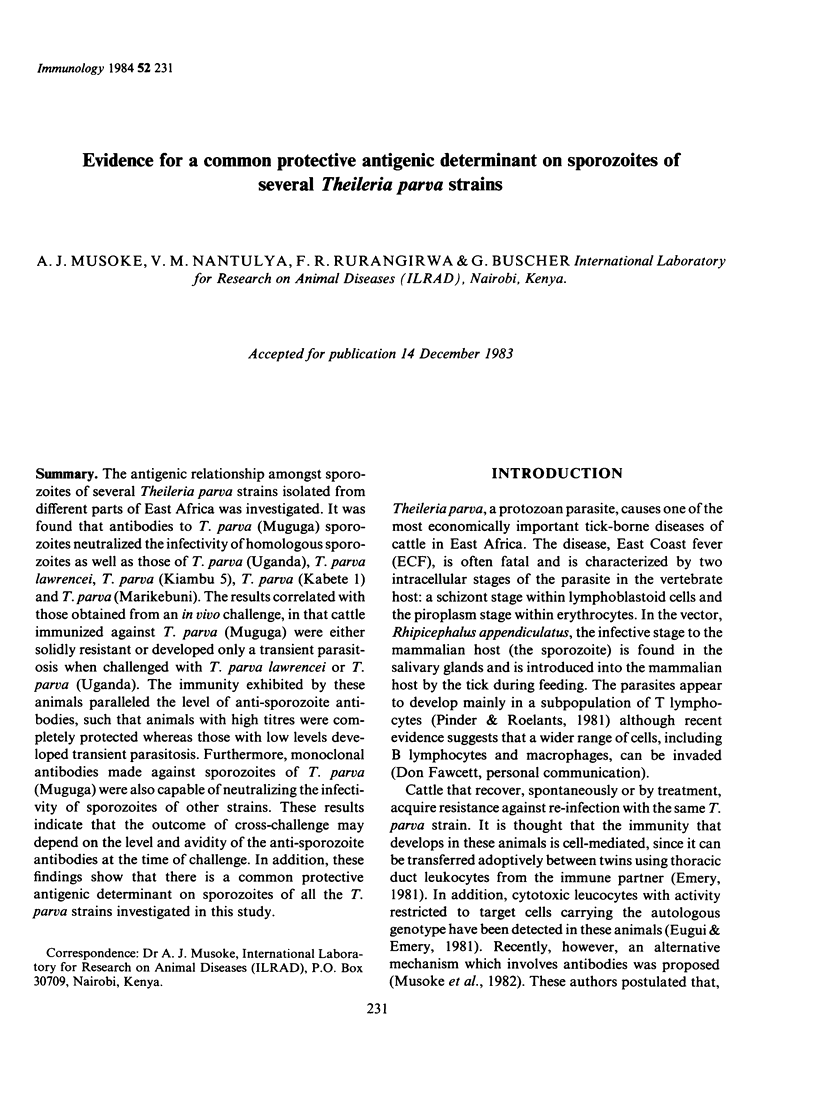
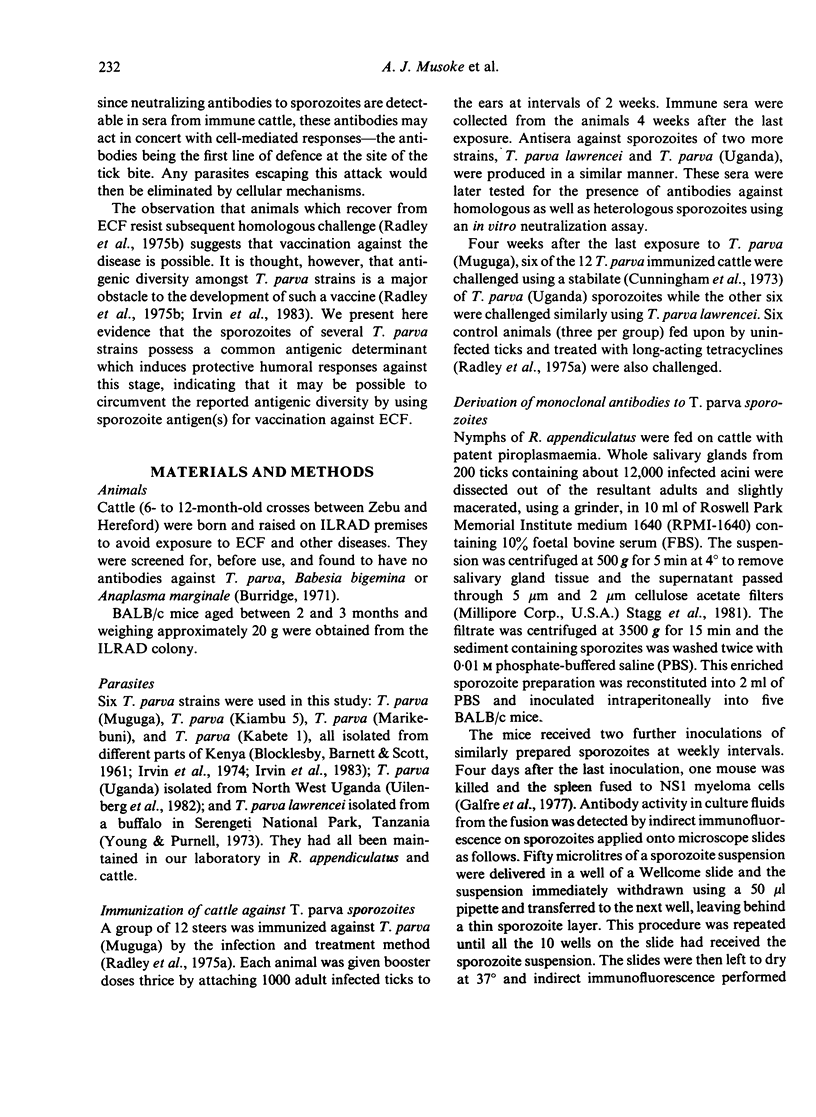
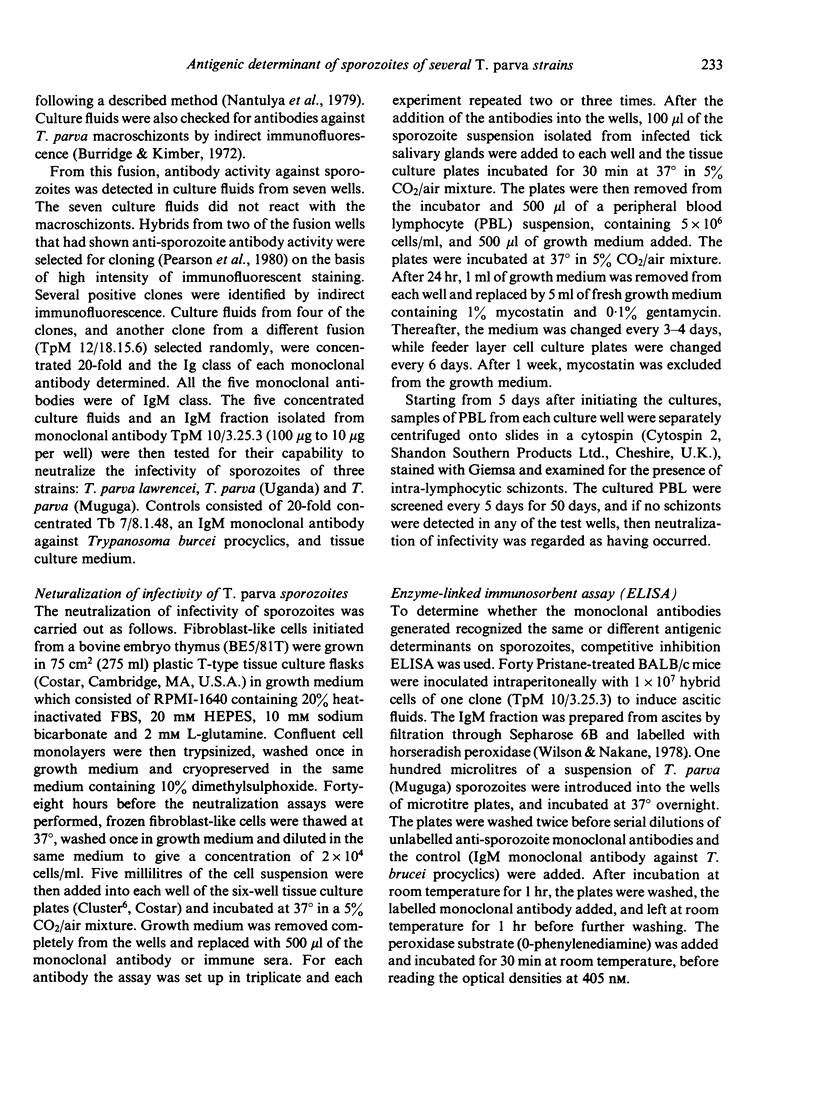
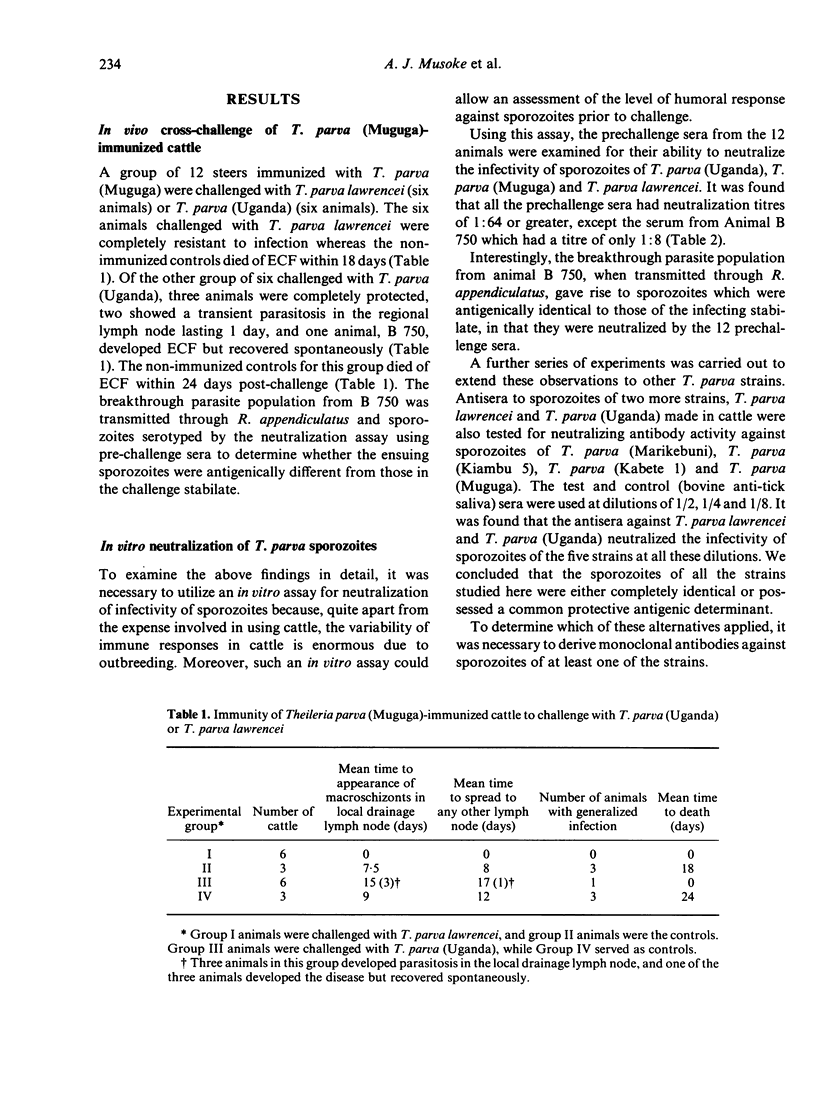
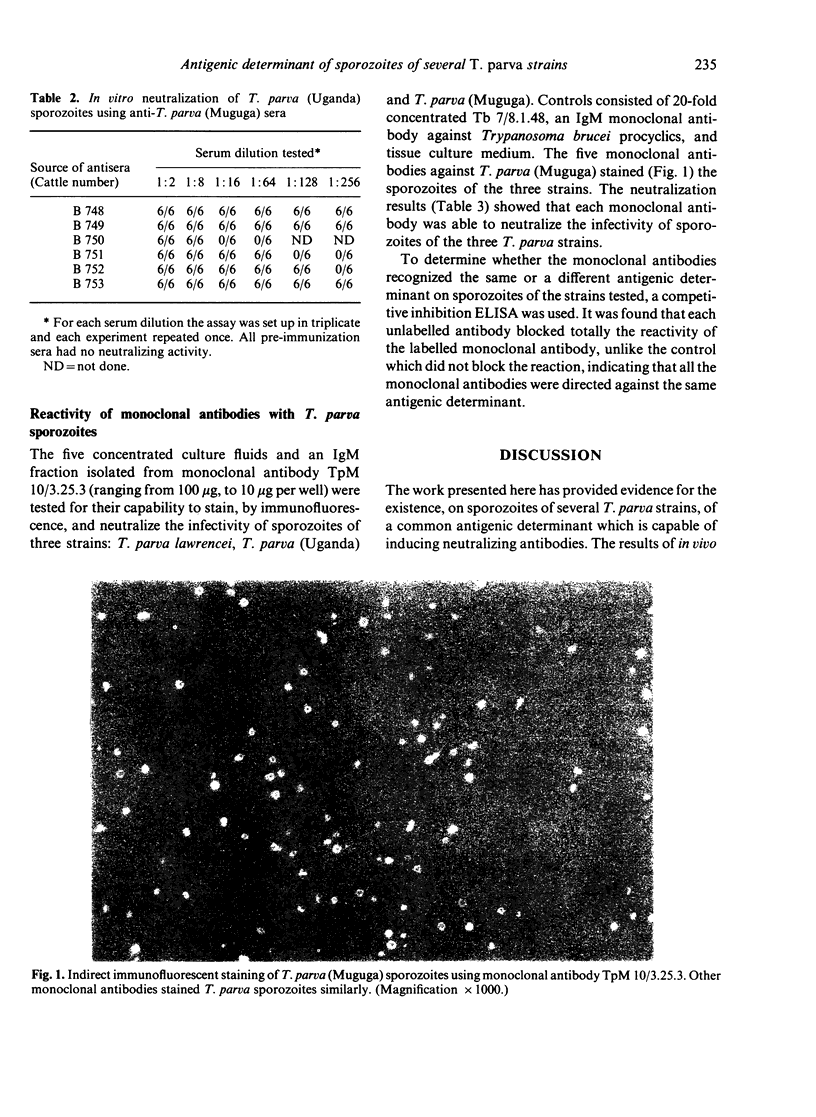
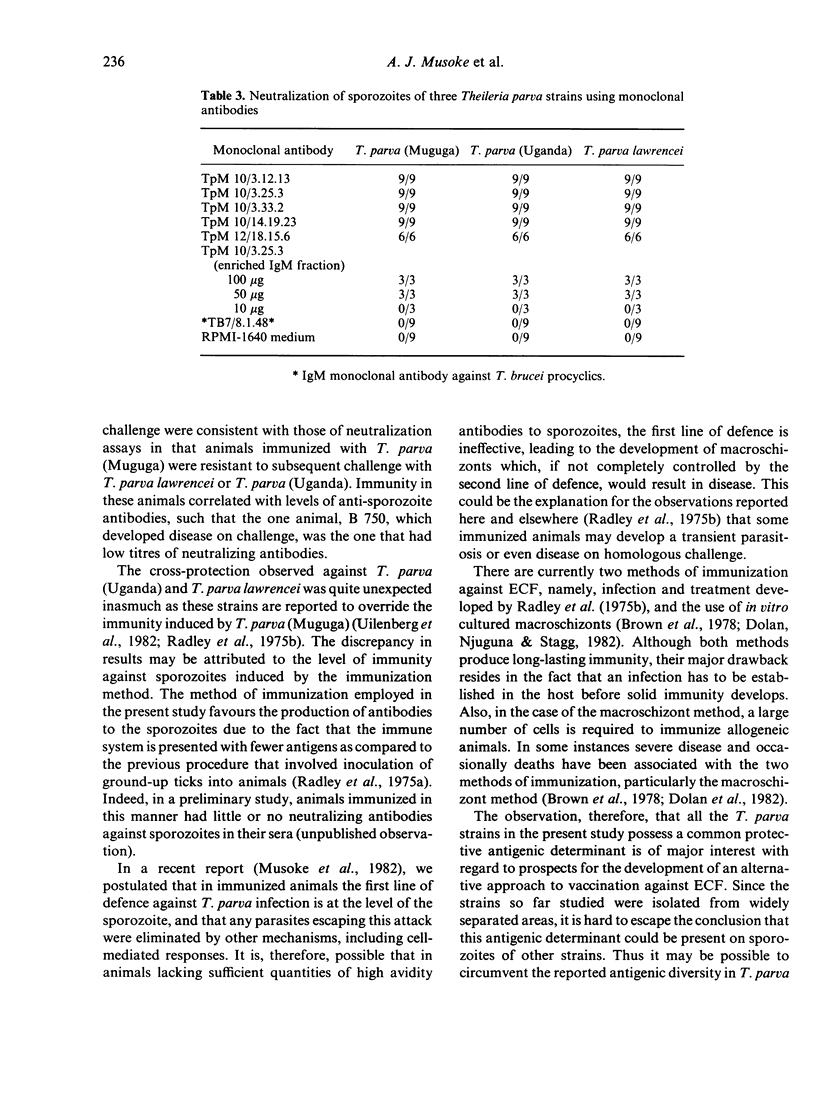
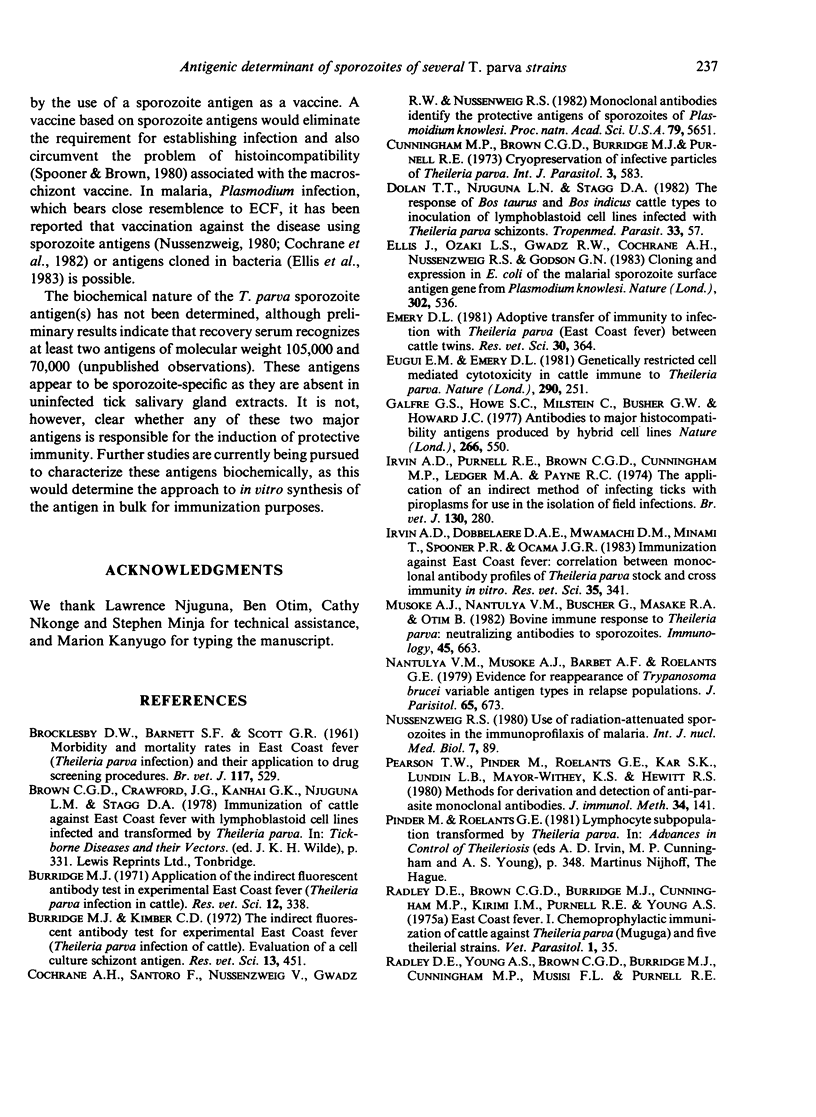
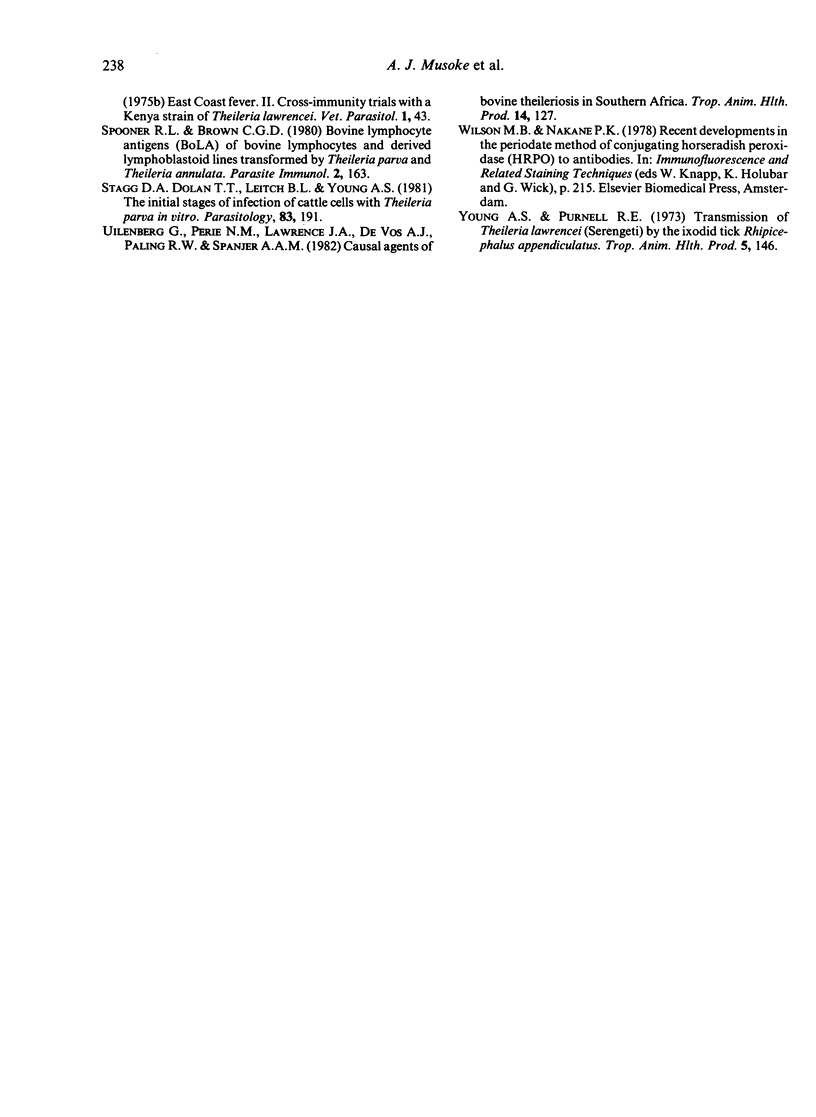
Images in this article
Selected References
These references are in PubMed. This may not be the complete list of references from this article.
- Burridge M. J. Application of the indirect fluorescent antibody test in experimental East Coast fever (Theileria parva infection of cattle). Res Vet Sci. 1971 Jul;12(4):338–341. [PubMed] [Google Scholar]
- Burridge M. J., Kimber C. D. The indirect fluorescent antibody test for experimental East Coast fever (Theileria parva infection of cattle). Evaluation of a cell culture schizont antigen. Res Vet Sci. 1972 Sep;13(5):451–455. [PubMed] [Google Scholar]
- Cochrane A. H., Santoro F., Nussenzweig V., Gwadz R. W., Nussenzweig R. S. Monoclonal antibodies identify the protective antigens of sporozoites of Plasmodium knowlesi. Proc Natl Acad Sci U S A. 1982 Sep;79(18):5651–5655. doi: 10.1073/pnas.79.18.5651. [DOI] [PMC free article] [PubMed] [Google Scholar]
- Cunningham M. P., Brown C. G., Burridge M. J., Purnell R. E. Cryopreservation of infective particles of Theileria parva. Int J Parasitol. 1973 Sep;3(5):583–587. doi: 10.1016/0020-7519(73)90082-9. [DOI] [PubMed] [Google Scholar]
- Dolan T. T., Njuguna L. N., Stagg D. A. The response of Bos taurus and Bos indicus cattle types to inoculation of lymphoblastoid cell lines infected with Theileria parva schizonts. Tropenmed Parasitol. 1982 Mar;33(1):57–62. [PubMed] [Google Scholar]
- Ellis J., Ozaki L. S., Gwadz R. W., Cochrane A. H., Nussenzweig V., Nussenzweig R. S., Godson G. N. Cloning and expression in E. coli of the malarial sporozoite surface antigen gene from Plasmodium knowlesi. Nature. 1983 Apr 7;302(5908):536–538. doi: 10.1038/302536a0. [DOI] [PubMed] [Google Scholar]
- Emery D. L. Adoptive transfer of immunity to infection with Theileria parva (East Coast fever) between cattle twins. Res Vet Sci. 1981 May;30(3):364–367. [PubMed] [Google Scholar]
- Eugui E. M., Emery D. L. Genetically restricted cell-mediated cytotoxicity in cattle immune to Theileria parva. Nature. 1981 Mar 19;290(5803):251–254. doi: 10.1038/290251a0. [DOI] [PubMed] [Google Scholar]
- Galfre G., Howe S. C., Milstein C., Butcher G. W., Howard J. C. Antibodies to major histocompatibility antigens produced by hybrid cell lines. Nature. 1977 Apr 7;266(5602):550–552. doi: 10.1038/266550a0. [DOI] [PubMed] [Google Scholar]
- Irvin A. D., Dobbelaere D. A., Mwamachi D. M., Minami T., Spooner P. R., Ocama J. G. Immunisation against East Coast fever: correlation between monoclonal antibody profiles of Theileria parva stocks and cross immunity in vivo. Res Vet Sci. 1983 Nov;35(3):341–346. [PubMed] [Google Scholar]
- Irvin A. D., Purnell R. E., Brown C. G., Cunningham M. P., Ledger M. A., Payne R. C. The application of an indirect method of infecting ticks with piroplasms for use in the isolation of field infections. Br Vet J. 1974 May-Jun;130(3):280–287. doi: 10.1016/s0007-1935(17)35894-3. [DOI] [PubMed] [Google Scholar]
- Musoke A. J., Nantulya V. M., Buscher G., Masake R. A., Otim B. Bovine immune response to Theileria parva: neutralizing antibodies to sporozoites. Immunology. 1982 Apr;45(4):663–668. [PMC free article] [PubMed] [Google Scholar]
- Nantulya V. M., Musoke A. J., Barbet A. F., Roelants G. E. Evidence for reappearance of Trypanosoma brucei variable antigen types in relapse populations. J Parasitol. 1979 Oct;65(5):673–679. [PubMed] [Google Scholar]
- Nussenzweig R. Use of radiation-attenuated sporozoites in the immunoprophylaxis of malaria. Int J Nucl Med Biol. 1980;7(2):89–96. doi: 10.1016/0047-0740(80)90026-1. [DOI] [PubMed] [Google Scholar]
- Pearson T. W., Pinder M., Roelants G. E., Kar S. K., Lundin L. B., Mayor-Withey K. S., Hwett R. S. Methods for derivation and detection of anti-parasite monoclonal antibodies. J Immunol Methods. 1980;34(2):141–154. doi: 10.1016/0022-1759(80)90168-4. [DOI] [PubMed] [Google Scholar]
- Spooner R. L., Brown C. G. Bovine lymphocyte antigens (BoLA) of bovine lymphocytes and derived lymphoblastoid lines transformed by Theileria parva and Theileria annulata. Parasite Immunol. 1980 Autumn;2(3):163–174. doi: 10.1111/j.1365-3024.1980.tb00051.x. [DOI] [PubMed] [Google Scholar]
- Stagg D. A., Dolan T. T., Leitch B. L., Young A. S. The initial stages of infection of cattle cells with Theileria parva sporozoites in vitro. Parasitology. 1981 Aug;83(Pt 1):191–197. doi: 10.1017/s0031182000050150. [DOI] [PubMed] [Google Scholar]
- Uilenberg G., Perié N. M., Lawrence J. A., de Vos A. J., Paling R. W., Spanjer A. A. Causal agents of bovine theileriosis in southern Africa. Trop Anim Health Prod. 1982 Aug;14(3):127–140. doi: 10.1007/BF02242143. [DOI] [PubMed] [Google Scholar]
- Young A. S., Purnell R. E. Transmission of Theileria lawrencei (Serengeti) by the ixodid tick, Rhipicephalus appendiculatus. Trop Anim Health Prod. 1973 Aug;5(3):146–152. doi: 10.1007/BF02251383. [DOI] [PubMed] [Google Scholar]



